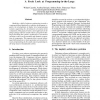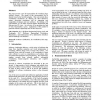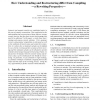SIGSOFT
1998
ACM
14 years 4 months ago
1998
ACM
Understanding large software systems is difficult. Traditionally, automated tools are used to assist program understanding. However, the representations constructed by these tool...
CSMR
1998
IEEE
14 years 4 months ago
1998
IEEE
While it is widely agreed that architectural simplicity is a key factor to the success of large software systems, it is not obvious how to measure architectural complexity. Our ap...
COMPSAC
1998
IEEE
14 years 4 months ago
1998
IEEE
Realizing a shift of software engineering towards a component-based approach to software development requires the development of higher level programming systems supporting the de...
IWPC
1999
IEEE
14 years 4 months ago
1999
IEEE
Recent research suggests that large software systems should have a documented system architecture. One form of documentation that may help describe the structure of software syste...
ICSM
1999
IEEE
14 years 4 months ago
1999
IEEE
Code duplication is one of the factors that severely complicates the maintenance and evolution of large software systems. Techniques for detecting duplicated code exist but rely m...
SOFTVIS
2003
ACM
14 years 5 months ago
2003
ACM
The paper presents a new 3D representation for visualizing large software systems. The origins of this representation can be directly traced to the SeeSoft metaphor. This work ext...
IWPC
2003
IEEE
14 years 5 months ago
2003
IEEE
Syntactic and semantic analysis are established topics in the area of compiler construction. Their application to the understanding and restructuring of large software systems rev...
MPC
2004
Springer
14 years 5 months ago
2004
Springer
The efficient representation and manipulation of data is one of the fundamental tasks in the construction of large software systems. Parametric polymorphism has been one of the mo...
ISOLA
2004
Springer
14 years 5 months ago
2004
Springer
The article is concerned with an approach to model based test development for large software systems. The approach presented is a part of UniTesK test development technology, which...
OOPSLA
2005
Springer
14 years 5 months ago
2005
Springer
An approach to managing the architecture of large software systems is presented. Dependencies are extracted from the code by a conventional static analysis, and shown in a tabular...






